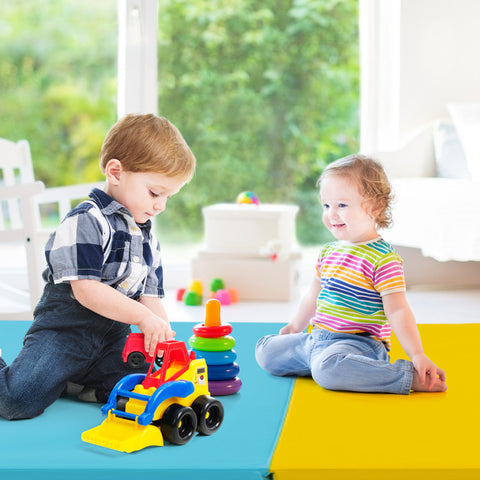News
The Hidden Importance of Edge Compression Resistance in Gymnastics Mats
When athletes think about a gymnastics mat, they often focus on thickness, foam density, or surface grip. But one characteristic that plays a massive role in safety and structural integrity is rarely discussed:
Edge Compression Resistance, a mat’s ability to maintain firmness and shape at the edges under pressure.
Edges are the most vulnerable points of any gymnastics mat. They experience frequent stress from landings, handling, dragging, stacking, and transport. Weak edges cause sagging, uneven surfaces, and even dangerous “edge collapse,” which can lead to twisted ankles and failed landings.
This article explores why edge compression resistance is crucial, how manufacturers engineer it, and how athletes can test it before buying.
What Is Edge Compression Resistance?
Edge compression resistance refers to a gymnastics mat’s ability to withstand applied force at its perimeter without deforming, sinking, or folding inwards.
Unlike central foam zones, edges lack equal structural support, making them more susceptible to:
- collapse
- bending
- tearing
- uneven rebound
A high-quality mat must resist compression at the edges, ensuring a stable, predictable landing surface across the entire mat.
Why Edge Compression Resistance Matters
1- Prevents Twisted Ankles and Balance Loss
Most slips and ankle injuries occur not in the middle of the mat, but at the edges where the surface bends under uneven pressure. Strong edge structure ensures that landings near the perimeter remain safe and controlled.
2- Maintains Structural Integrity Over Time
Weak edges deteriorate faster, causing:
- foam crumbling
- vinyl tearing
- permanent dents
- uneven height across the mat
Once the edges go soft, the entire mat becomes unstable.
3- Essential for Multi-Mat Configurations
In gyms, mats are often placed side-by-side.
Poor edge resistance leads to:
- gaps
- dips
- uneven transitions
This becomes dangerous during tumbling passes or handsprings.
4- Improves Aesthetic and Professional Appearance
Mats with strong edge construction maintain:
- crisp lines
- rectangular shape
- uniform thickness
Important for professional studios, competition events, and televised sports.
5- Crucial During Transport and Storage
Edges take the hardest beating when mats are:
- carried
- dragged
- stacked
- stored vertically
High compression resistance prevents fraying and collapse during handling.
How Manufacturers Create Edge Compression Resistance
1- Reinforced Side Panels
High-end mats include stiffened sidewalls made from:
- EVA-reinforced foam
- high-density polyethylene boards (HDPE)
- cross-linked polymer strips
These prevent edge crushing under load.
2- Dual-Density Foam Construction
Manufacturers often place:
- softer foam in the core for shock absorption
- firmer foam around the perimeter for stability
This creates a balanced mat with controlled edges.
3- High-Tension Vinyl Wrapping
Edge durability is significantly influenced by cover tension.
Premium mats use:
- tightly stretched vinyl
- heat-sealed corner joints
- reinforced stitching patterns
to prevent sagging and splitting.
4- Edge Binding and Anti-Collapse Corners
Corners are the first part of a mat to deform.
Modern mats use:
- triple-stitched binding
- internal corner guards
- pressure-resistant foam inserts
to preserve shape.
How to Test Edge Compression Resistance Before Buying
1- Thumb Press Test
Press the edge with your thumb.
✔ Good resistance = firm, minimal sinking
✘ Poor resistance = soft, rolls inward
2- Drop Test at the Perimeter
Drop your body weight or a medicine ball on the edge.
A quality mat will not bend or cave under impact.
3- Vertical Storage Test
Store the mat upright.
✔ Strong edges = maintains shape
✘ Weak edges = visible bulging or flattening
4- Gap Alignment Test (for multi-mat setups)
Place two mats together.
- If the edges sag, you will see a gap or dip.
- Strong edges create a seamless surface.
Who Needs Mats With High Edge Compression Resistance?
- Competitive gymnasts
- Professional studios
- Cheering and tumbling schools
- Home athletes with limited space
- Gyms that frequently rearrange flooring
- Outdoor or mobile trainers
- Any facility using multiple mats side-by-side
Common Problems Caused by Low Edge Compression Resistance
- raised vinyl edges
- uneven landings
- ankle or wrist injuries
- mats losing rectangular shape
- excessive foam wear
- difficulty aligning mats
- tripping hazards in tumbling sequences
Which Materials Offer the Best Edge Stability?
Top Recommended Materials:
- High-density EVA perimeter strips
- Reinforced polyethylene (PE) blocks
- Cross-linked polyethylene (XPE)
- Triple-layer PVC vinyl with stitching
- Dual-density hybrid foam
These materials provide long-term resistance even under heavy daily training.
Conclusion
Edge compression resistance is an overlooked but crucial characteristic of gymnastics mats. Edges endure the majority of structural stress—through landings, storage, transport, and daily wear. If the edges fail, the entire mat becomes unstable, unsafe, and short-lived.
Choosing a mat with strong edge resistance ensures:
- safer landings
- predictable performance
- longer lifespan
- consistent shape retention
- improved multi-mat compatibility
Coaches, buyers, and athletes should always evaluate edge strength—not just foam thickness or color—when selecting a high-performance mat.
FAQs
1. What causes edge compression in gymnastics mats?
Constant pressure, dragging, stacking, and foam aging cause edge collapse over time.
2. Are reinforced-edge mats more expensive?
Slightly, but the longer lifespan and improved safety make them cost-effective.
3. Does edge compression affect competition performance?
Yes. Uneven edges can disrupt landings and transitions between equipment.
4. Can edge compression resistance be restored?
No. Once foam collapses, only replacement or re-foaming can fix it.
5. Is this feature important for home use?
Very. Home mats are often folded, carried, and stored frequently—putting extra stress on edges.


